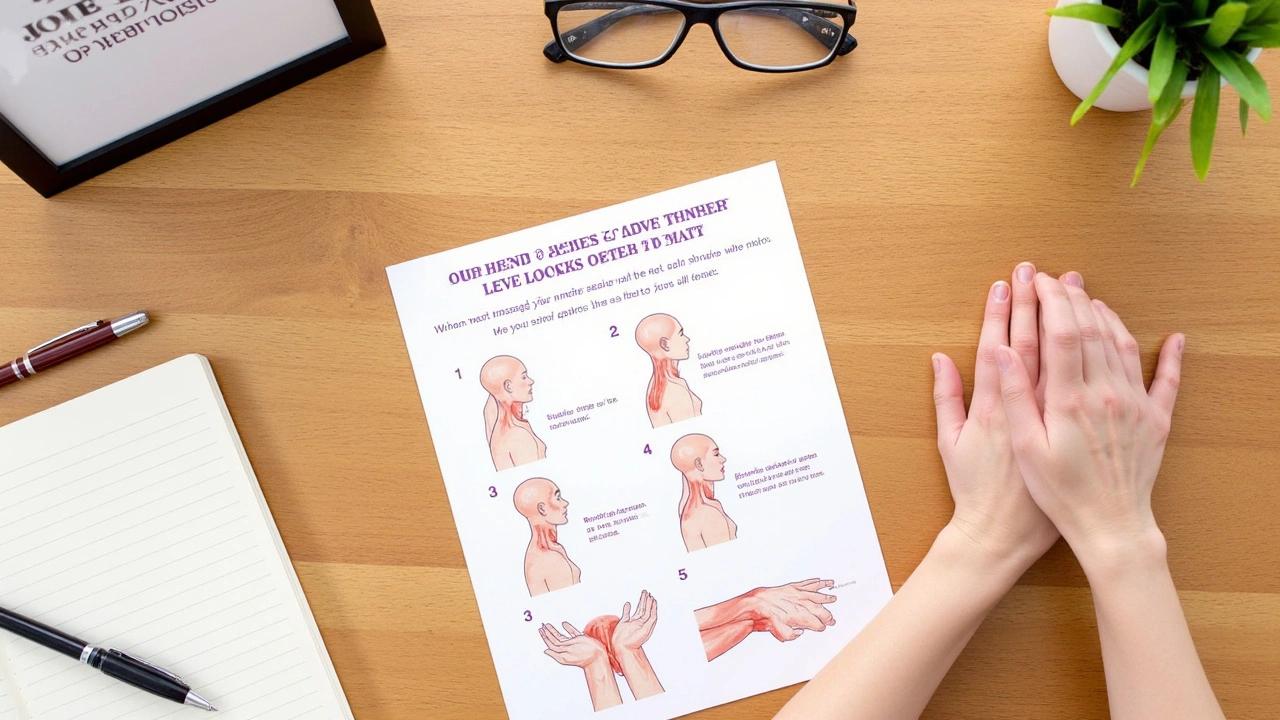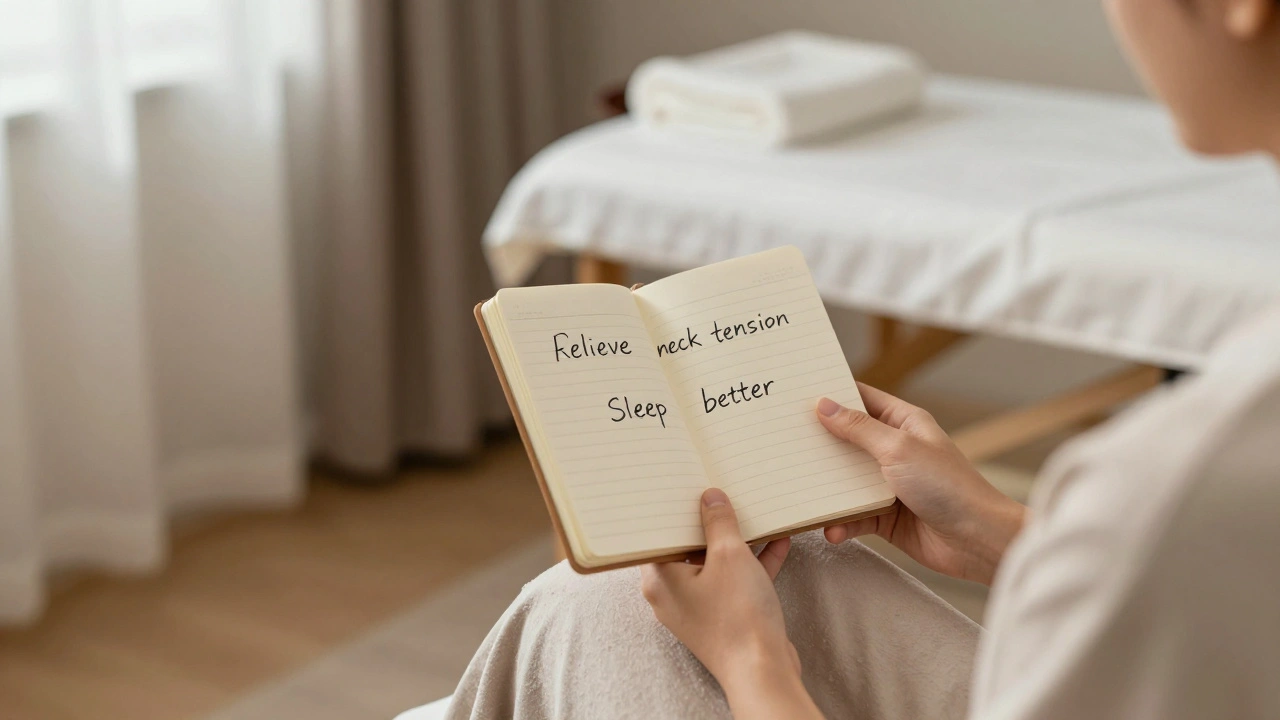Massage Therapist Techniques for Office Workers: Easing Tension Fast

Stuck at your desk all day? You’re not alone. Most office workers spend hours hunched over a keyboard, shoulders creeping higher as the work piles up. No wonder so many of us deal with stiff necks, tight shoulders, and that constant ache in the lower back.
The strain builds up in places you probably didn’t even realize—think your forearms and hands from typing, plus sore glutes from sitting for way too long. The real kicker? Your body starts to feel the effects even after just one day at the desk, let alone weeks or months.
If you’ve ever tried rubbing your own neck at your desk only to realize it barely helps, you’re exactly the kind of person massage therapists have in mind when they design their go-to techniques for office workers. The good news is, with a few simple changes and tricks, you can break the cycle of tension before it really takes hold.
- Why Office Work Wrecks Your Body
- What Massage Therapists Target First
- Quick At-Desk Massage Moves
- What to Expect at a Massage Session
- Habits That Make a Real Difference
Why Office Work Wrecks Your Body
Sitting for hours isn’t just uncomfortable—it’s linked to real health issues. Research shows office workers sit almost 10 hours a day on average. That’s a problem because your body isn’t made to stay still that long, especially in the same slouched position.
The way most people sit at a desk causes the shoulders to hunch, the head to poke forward, and the lower back to round. This piles tension onto your neck, mid-back, and lower spine. It’s not just your back, either. Typing and mouse work force tiny muscles in your hands and forearms to stay active, sometimes for longer than your body can comfortably handle.
Let’s look at what’s really going on during a typical office day:
| Part of Body | Common Issue | Main Cause |
|---|---|---|
| Neck and shoulders | Tightness, tension | Hunching and looking at screens |
| Lower back | Aching, stiffness | Sitting without lumbar support |
| Wrists and forearms | Pain, numbness | Constant typing and improper desk height |
| Hips and glutes | Numbness, weakness | Extended sitting |
People don’t always realize just how quickly tension builds up. According to a well-known ergonomics study, muscle fatigue and strain can start to set in within 20 minutes of being in a single position. By the end of a long workday, that adds up—especially if you do the same thing day after day.
Here’s where a massage therapist can make a real difference. They understand the exact muscles that flare up for office workers and can help loosen things up before tension turns into something worse, like chronic pain or stubborn knots.
What Massage Therapists Target First
When you head in for a session, most massage therapists go straight for the spots that scream for help: your neck, shoulders, and upper back. Those spots take the biggest hit when you’re glued to a computer all day. Therapists know that poor posture—like craning your head toward the screen—makes neck muscles tense up fast. Shoulders start rolling forward, which leads to soreness across your upper back and between your shoulder blades.
Interestingly, many therapists also pay close attention to your forearms and hands. If you spend a lot of time typing and using a mouse, tiny muscles in your hands can get tight, sometimes leading to what’s called “tech hand.” Therapists often use slow thumb pressure and gentle stretching to loosen these spots.
Here are the top areas massage therapists almost always address in office workers:
- Neck and base of the skull: This is ground zero for tension headaches and stiffness.
- Shoulders: Where knots gather from slouching and stress.
- Upper back (especially between the shoulder blades): Gets tight from poor desk posture.
- Forearms and wrists: For relief from endless typing, texting, and mouse work.
- Lower back: Achy from hours of sitting without support.
One well-known therapist, Angela Stevens, sums it up perfectly:
“The first thing I look for is that rock-solid tension around the shoulders and base of the neck. It’s almost always there in office workers, and it’s a sign the body needs a reset.”
Rather than a quick head-to-toe routine, these pros zone in on the areas that actually bug you the most. They’ll use deep pressure, broad strokes, and a combo of kneading and stretching to get blood flowing and loosen those stubborn knots. The point is real relief where office workers notice it most.

Quick At-Desk Massage Moves
You don’t need a massage table or fancy oils to get real relief at your desk. For office workers, even a few minutes tackling muscle tightness can undo hours of sitting. Here are solid, therapist-approved moves that make a difference when you’re crunched for time.
- Neck and Shoulder Release: Drop your shoulders away from your ears and use your fingertips to slowly knead small circles at the base of your skull. Work your way down the side of your neck to the tops of your shoulders. Go slow, adding a bit of pressure where you feel knots.
- Wrist and Forearm Squeeze: If you type all day, this one’s a game-changer. Hold your forearm with your opposite hand, gently squeezing along the muscle from your elbow down to your wrist, and repeat a few times. Flip your hand palm up and, using your thumb, massage along the underside of your forearm in small circles.
- Lower Back Stretch: Sit up straight (no slouching!), put your fists on either side of your spine above your hips, and lean back gently into them. Roll your fists up and down your lower back in slow, steady movements.
- Temple and Jaw Press: Clenching your jaw or squinting at your screen? Place your fingertips at your temples and use circular motions, then slide down to your jaw muscles—right where you chew—and gently knead those tense spots.
Most people feel a difference after just two or three minutes of focused self-massage. According to a 2022 study published in the journal Work, office workers who practiced quick desk massage twice a day reported 23% less muscle soreness by the end of the week.
| Common Problem Area | Desk Massage Move | Time Needed |
|---|---|---|
| Neck & Shoulders | Slow circular kneading | 2 minutes |
| Forearms | Thumb & squeeze massage | 1-2 minutes |
| Lower Back | Fist rolling | 2 minutes |
| Jaw & Temples | Gentle kneading | 1 minute |
If you stay consistent, these small moves can keep tension from getting worse. Add them to your day—before a video call, after lunch, or whenever you notice tightness setting in. Your body will thank you for listening.
What to Expect at a Massage Session
Walking into your first appointment with a massage therapist can be a bit nerve-racking, but it's usually way more relaxed than people imagine. Before you even hit the table, you'll fill out a short form about your health and areas bothering you—don't skip this, it helps your therapist figure out where to focus.
Once you're in the room, most therapists will ask you where you feel tension and what your typical workday looks like. They usually start with gentle pressure to warm up your muscles, then move on to deeper kneading in problem spots. Expect special attention to your neck, shoulders, upper back, and even your forearms if you mention keyboard pain. Therapists use a combo of Swedish and deep tissue techniques for desk job aches.
Sessions for office workers often last 30 to 60 minutes. Don’t be shy about saying if something feels too strong or too light—your feedback actually helps them help you. And yes, you’ll usually be covered with a sheet or towel the whole time except for the part they’re working on (no awkwardness needed).
Most people feel a mix of deep relaxation and a pleasant soreness afterwards, kind of like you just finished a light workout. Drinking a glass or two of water post-massage actually helps your muscles recover better.
| Fact | Details |
|---|---|
| Average Cost | $60-120 per one-hour session (US, 2024) |
| Most Requested Areas for Office Workers | Neck, shoulders, lower back, wrists |
| How Often Office Workers Go | Every 2-4 weeks for maintenance |
| Typical Session Length | 30-60 minutes |
If it’s your first time, here’s how to make the most of your visit:
- Show up a little early to relax (rushing in makes tension worse).
- Be honest about your pain points and daily habits—good therapists don’t judge.
- Wear comfy clothes; you’ll change or be asked to undress to your comfort level.
- Don’t be shy about communication during the session; it’s your time.
- Plan to take it easy for the rest of the day if possible.
After just one session, most office workers notice they can turn their head easier or reach those high shelves without the usual twinge. It’s not magic, but it’s as close as it gets for desk-bound bodies.

Habits That Make a Real Difference
Tight muscles don’t just go away after one quick stretch. Therapists keep saying the same thing: your daily habits have a bigger impact on your body than any one massage. If you want lasting relief, it’s all about what you do day-in and day-out.
Take a look at this eye-opener: research from the American Institute of Stress found that office workers who get up at least once every hour report 31% less muscle discomfort compared to those stuck to their seats. Tiny changes add up fast—even just shifting your seat position every 30 minutes can help.
Here are habits that actually matter when it comes to fighting office aches:
- Massage therapist tip: Schedule true breaks—stand up, walk, and roll out your shoulders at least every hour. Set a reminder on your phone to nudge you.
- Check your desk set-up. Screens should be eye-level, and feet flat on the floor. If your shoulders are creeping up, lower your chair or raise your monitor.
- Use a tennis ball or massage ball under your feet or against a wall for a quick self-massage when things feel tight.
- Drink water regularly. Dehydrated muscles get sore much faster, so keep a bottle at your desk.
- Try the "20-20-20" rule: every 20 minutes, look 20 feet away for 20 seconds to help relax neck and eye muscles.
Here’s a quick snapshot of what works (and what doesn’t) based on user feedback among office workers:
| Habit | Reported Effectiveness (%) |
|---|---|
| Taking hourly movement breaks | 79 |
| Desk stretching | 66 |
| Adjusting chair and monitor height | 55 |
| Hydration | 43 |
| Random self-massage (no routine) | 18 |
Small habits add up, and the most effective routines are simple. Don’t underestimate the power of a quick walk, a little water, and paying attention to how your desk is set up. Your muscles will thank you later.


